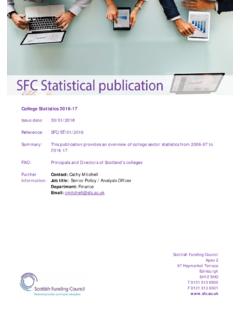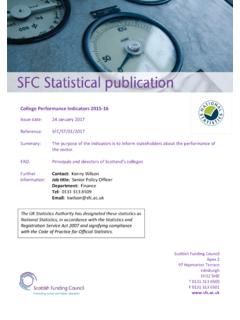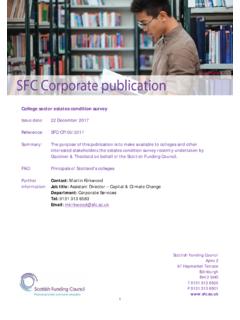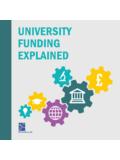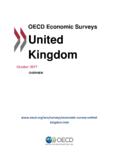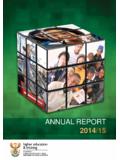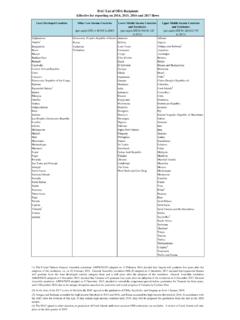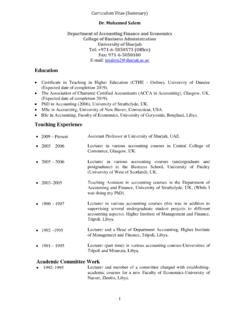Transcription of Scottish Funding Council Report on Widening …
1 Scottish Funding Council Report on Widening access 2015-16 Issue date: Reference: Summary: FAO: 26 September 2017 SFC/ST/08/2017 This is the first release of the SFC Report on Widening access , the successor publication to SFC s Learning for All publication. This Report presents data towards the Commission on Widening access targets, and on Scottish -domiciled entrants to higher and further education in Scotland by socio-economic deprivation, gender, ethnicity, disability, Care Experience and Age. Scottish Government, Principals and Directors of Scotland s colleges and universities, all other interested parties. Further information: Contact: Cathy Mitchell Job title: Senior Policy Officer/Analyst Department: Finance Directorate Email: Scottish Funding Council Apex 2 97 Haymarket Terrace Edinburgh EH12 5HD T 0131 313 6500 F 0131 313 6501 Contents Section 1: Introduction.
2 4 Section 2: CoWA Key Indicators .. 5 CoWA Recommendation 32 .. 5 CoWA Key Indicators .. 5 Section 3: Report Content .. 8 Section 4: Socio-Economic Status .. 10 Socio-economic Status and Level of Study .. 11 Socio-economic Status and Age .. 13 College Success and University Retention .. 14 Section 5: Gender .. 17 Gender and Age .. 18 Gender and Subject .. 20 College Success and University Retention .. 21 Section 6: Ethnicity .. 23 Black and Minority Ethnic (BME) .. 23 BME breakdown and Socio-economic Status .. 23 College Success and University Retention .. 25 Section 7: Disability .. 27 Disability Breakdown, Age and Socio-economic Status .. 27 College Success and University Retention .. 29 Section 8: Care Experienced Learners .. 30 College Success and University Retention.
3 31 Section 9: Conclusion and Future Publications .. 32 Annex A: Report Content and Coverage .. 33 University entrants Section 3 onwards .. 33 College entrants Section 3 onwards .. 33 University Retention .. 34 College Success .. 34 Articulation .. 34 Data Specifics .. 34 3 Executive Summary This is the first SFC Report on Widening access , the successor publication to SFC s Learning for All publication. This publication presents data specifically towards the Commission on Widening access (CoWA) targets and further access data, in line with SFC Outcome Agreement measures, on socio-economic status and protected characteristics. The key points from this Report are: CoWA Key Indicators In 2015-16, of Scottish domiciled full-time first degree entrants to university were from the 20% most deprived areas.
4 An increase of 2 percentage points is required to meet the CoWA interim target of 16% by 2021. For entrants to undergraduate higher education the proportion from the 20% most deprived areas was in 2015-16. In 2015-16, retention rates for care experienced students were percentage points lower than the overall sector retention rate. Retention rates for those from the most deprived 20% was percentage points lower than the sector rate, an increase from in 2013-14. SFC Widening access Update In 2015-16, 59% of full-time Scottish domiciled entrants to substantive higher education were to university and 41% were to college In 2015-16, those from the most deprived 20% of SFC Scottish Index of Multiple Deprivation (SIMD) population made up of the full-time first degree population, of full-time HE students at college and of full-time FE students at college.
5 These proportions have all shown increases in the most recent years and over the time period since 2002-03 shown. The gender imbalance of overall OA entrants to university in 2015-16 is percentage points, with females accounting for of entrants. Males have a lower proportion of entrants from the most deprived 20%. At full-time first degree level in 2015-16 it was , compared to for female entrants. In 2015-16, those from an ethnic minority background made up of the full-time first degree population, of full-time HE students at college and of full-time FE students at college. In 2015-16, those with a declared disability made up of the full-time first degree population, of full-time HE students at college and of full-time FE students at college. 4 Section 1: Introduction 1.
6 The tenth update of SFC s Learning for All Report was published in August 2016. In this Report , SFC committed to reviewing the publication in terms of its scope and content with a view to improving the analysis provided on equality and diversity across both the college and university sectors. This has been done considering the final Report of the Scottish Government s Commission on Widening access (CoWA) and the recommendation that the Scottish Funding Council and the Scottish Government should enhance the analyses and publication of data on fair access and is in line with further SFC efforts to improve consistency around reporting of data relating to access to higher and further education. 2. This review has resulted in this SFC Report on Widening access , superseding the Learning for All publication.
7 However, SFC s commitment to reviewing our publication is ongoing, and after publication we would like to offer users the chance to consult on the changes from Learning for All and on any other aspects of this publication. Details of this consultation are forthcoming and it is our intention to publish the second Report on Widening access , for academic year 2016-17, earlier next year. This should be viewed as an interim Report and we will seek to finalise content and coverage between now and the next SFC Report on Widening access update. 3. The Report has two main strands, the first on the key CoWA indicators and targets, and the second presenting a wider analysis of access to further and higher education similar to what would be expected from previous Learning for All publications.
8 These two strands overlap in the areas of socio-economic deprivation and care experienced learners, meaning the data for these two areas is presented twice in this Report . However, the data presented in each of these strands differ due to the data specification and focus used. 4. In Section 2, data are presented on the same basis as the targets proposed by the Commission on Widening access . In the remaining sections, data are presented on a basis that is broadly in line with the measures currently included in Outcome Agreements, in line with previous SFC reports on Widening access . Changes are being implemented to ensure they are aligned in future years and further details of the differences are given throughout this Report . This Report shows data for Scottish -domiciled students only.
9 5 Section 2: CoWA Key Indicators 5. This section presents data for the CoWA targets as laid out in Recommendation 32 of the Final Report of the Commission on Widening access . CoWA Recommendation 32 6. Recommendation 32 states that: By 2030, students from the 20% most deprived backgrounds should represent 20% of entrants to higher education. Equality of access should be seen in both the college sector and the university sector. 7. And that to drive progress toward this goal: By 2021, students from the 20% most deprived backgrounds should represent at least 16% of full-time first degree entrants to Scottish universities as a whole. By 2026, students from the 20% most deprived backgrounds should represent at least 18% of full-time first degree entrants to Scottish universities as a whole.
10 8. Relating to the CoWA target for individual universities: By 2021, students from the 20% most deprived backgrounds should represent at least 10% of full-time first degree entrants to every individual Scottish university. 9. The following tables show national performance on these measures using the latest three years of data. For the CoWA targets, all undergraduate HE includes all entrants to undergraduate HE courses at college and university. The background tables online show these figure broken down by institution. 10. The Commission s final Report was published during the 2016-17 admissions cycle. This means the initial impact of the Commission s recommendations and targets is unlikely to be apparent in entrant data until 2017-18. CoWA Key Indicators 11. Table 1 shows the key indicators for entrants to full-time first degree study and all undergraduate HE study at Scottish institutions.

